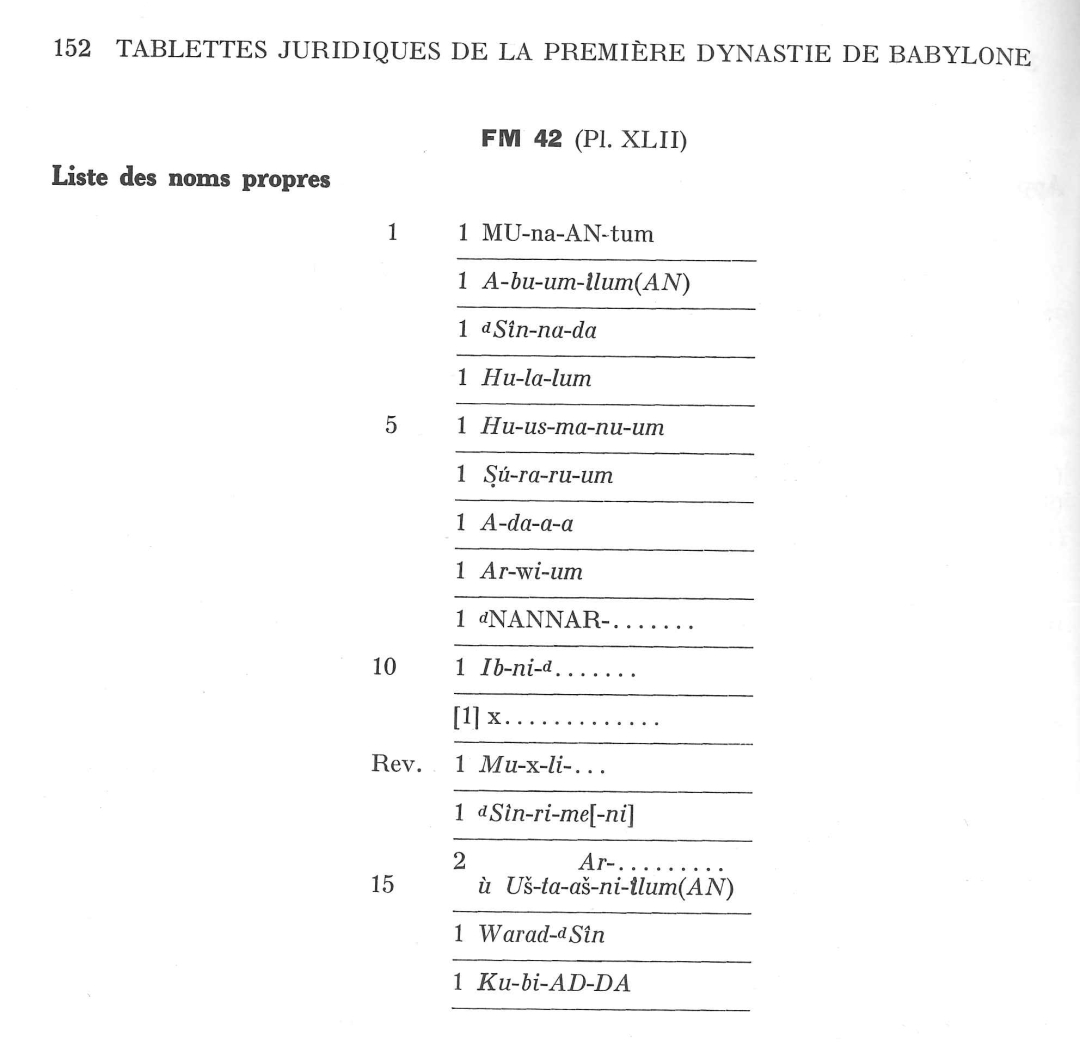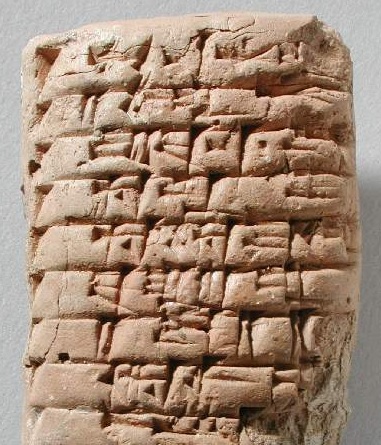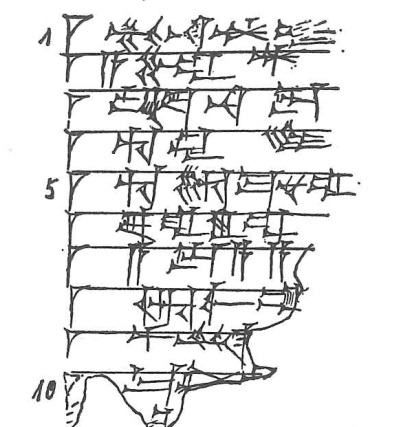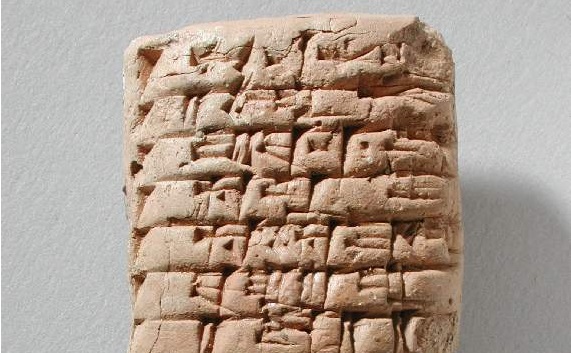For the third of our posts looking at the objects in the CREWS Display at the Fitzwilliam Museum, we’re going to turn our attention to probably the oldest item we have on display: this cuneiform tablet.

Cuneiform means ‘wedge-shaped’; as you can see, the signs in the writing-system are made of lots of small triangular indentations made into the soft clay with a reed or stylus. There are actually a few varieties of cuneiform writing. We’ve mentioned the Ugaritic cuneiform alphabet a few times before – that’s what my research mainly focuses on and we’ll be coming back to it later in this series. Much more widely used than that, though, and for an extremely long time – several thousand years – was the logosyllabic system used first to write Sumerian, and then adapted for the various dialects of the Akkadian language.
But what exactly does ‘logosyllabic’ mean? As we saw with Pippa’s look at the Cypriot syllabic writing on the Idalion bilingual, a syllabic writing system uses a sign to represent a single syllable, like ‘ma’ or ‘an’. The majority of Akkadian signs work in this way. So what about the ‘logo-’ bit? As well as being syllabic, Akkadian also has a logographic component, where a sign can be read as a whole word. What makes it especially complicated is that some signs have both syllabic and logographic readings – and often several possible options for both! And then for added spice, there are what we call determinatives – signs which don’t represent a spoken sound at all, but indicate what kind of thing the word that follows is. So here’s an example we can actually see in this tablet:
These are two versions of the same sign. As you might be able to guess, it originally started off as a pictogram – a drawing of a star, before becoming more simplified over time. In the Sumerian language, it was read as DINGIR, which meant ‘god’. When the same signs were borrowed for Akkadian, it gained other readings. In Akkadian this can be read as a syllable ‘an’, but it also retained its Sumerian reading, so could also be read as the Akkadian word for ‘god’, ‘ilum’. But it can also be read a third way, not as a word at all, but as a determinative, indicating that the name that follows belongs to a god.
The tablet in our exhibition is an early Babylonian one, possibly from the city of Sippar. Like many clay tablets that came to museums in the 19th and early 20th centuries, it was bought rather than discovered during a rigorously-conducted archaeological dig, so we don’t have much of the important contextual information about where it came from. It most likely belongs to the first dynasty of Babylon, which dates to around 1800-1700 BC. Mesopotamian history is extremely long and complicated, and is characterised by the rising and falling and rising again of a number of different states and empires within the overall umbrella of Mesopotamian culture. After Sumerian died out as a spoken language, all these societies spoke the Akkadian language, but unsurprisingly, we see lots of dialectal variations and developments in the writing system, depending on where and when it comes from – an Old Babylonian tablet looks, and reads, very differently from, say, a Neo-Assyrian one.
If we’re right about this tablet being an Old Babylonian one, then it hails from one of our best-documented periods for Mesopotamian writing. We have a huge wealth of written material from this period, including lots of information on how scribes were trained.
I’ve told you lots about the background of cuneiform writing, but I haven’t told you much yet about what this tablet actually says. It’s actually a list of names:


Almost every line begins with the sign for ‘1’, which is followed by a personal name. The 1-sign could also be read as a male determinative, but in this case it’s probably a ‘1’ because in one line it alternates with a ‘2’. These are nice easy signs to spot because they’re just vertical lines corresponding to the number – a bit like our system of tallying.

If we look at the names themselves, we can see some of the different ways of reading signs I’ve mentioned. Maybe you can make out the last sign of the second line? It’s a bit tricky in the photo because it overlaps the line-ruling, but it’s clearer on the drawing. It’s the an/DINGIR sign we saw above. Here it’s read logographically as ‘ilum’, meaning ‘god’, but it’s not a word in itself. It actually makes up the end of a man’s name: ‘Abumilum’. ‘Abum’ means ‘father’, so this man’s name would translate as something like ‘father is god’, or ‘god is father’.

The same sign pops up again on the next line, just after the ‘1’. Again, it’s a little hard to make out because it’s smooshed up against the line-ruling, but I hope you can spot it. Here it’s actually a determinative because the name that follows is ‘Sinnada’ and the first element – Sin – is the name of a god. In Mesopotamia, just like in lots of other societies, it was very common for people’s names to include the names of deities.
I hope now if you look again at the transcription given above, you’ll be able to decipher it a little. The bits in upper case are logographic readings and the little superscript d stands for DINGIR when it’s used as a determinative – so you know that anything that follows will be a god’s name.
Unfortunately, we have no way of knowing what this list of names might have been used for. Lists like this are really common in Mesopotamia and in my own area of Ugarit. Usually they’re for some sort of administration, such as tax records, censuses or distributing goods. Sometimes they have headings that help us know, but often they don’t – in the same way that we often don’t bother to write a formal heading on a note we’ve jotted down, or a shopping list.
I hope this has given you a bit of insight into the wonderful – and often confusing – world of Mesopotamian cuneiform! We’ll be back soon with a look at another object from the exhibition.
~ Philip Boyes (Research Associate on the CREWS project)





Very well explained Thank you.
LikeLike